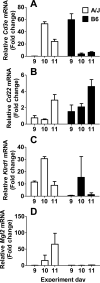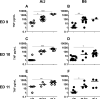Differential roles of inflammation and apoptosis in initiation of mid-gestational abortion in malaria-infected C57BL/6 and A/J mice
- PMID: 25956987
- PMCID: PMC4466201
- DOI: 10.1016/j.placenta.2015.04.007
Differential roles of inflammation and apoptosis in initiation of mid-gestational abortion in malaria-infected C57BL/6 and A/J mice
Abstract
Introduction: Plasmodium chabaudi AS-infection in pregnant A/J and C57BL/6J mice results in mid-gestational pregnancy loss. Although associated with increased systemic and placental pro-inflammatory responses and coagulopathy, the molecular mechanisms that underlie poor pregnancy outcomes in these mice are not yet fully understood. This study investigates the relationships between inflammation, apoptosis and malaria-induced pregnancy loss.
Methods: Infection with P. chabaudi AS in early murine pregnancy and term human placental tissues from an endemic setting were assessed by histology, immunohistochemistry, TUNEL staining, real-time PCR, flow cytometry, western blot, and ELISA.
Results: Quantitative PCR reveals accumulation of lymphocytes and monocytes and upregulation of chemokines that attract these cell types in malaria-exposed mid-gestational A/J conceptuses. Monocyte accumulation is confirmed by flow cytometry and placental immunohistochemistry. Concurrent with initiation of malaria-induced abortion, markers of apoptosis are evident in the junctional zone, but not the labyrinth, of A/J placentae. In contrast, mid-gestation conceptuses in infected C57BL/6J lack evidence for monocyte accumulation, exhibiting low or no in situ placental staining despite trophoblast immunoreactivity for the monokine, CCL2. Additionally, placental apoptosis is not consistently observed, and when evident, appears after malaria-induced abortion typically initiates. Similarly, trophoblast apoptosis in term human placental malaria is not observed. Of those studied, a sole common feature of malaria-induced abortion in A/J and C57BL/6J mice is elevation of plasma tumor necrosis factor.
Discussion: Consistent with our previous observations, tumor necrosis factor is likely to be a central driver of malaria-induced pregnancy loss in both strains, but likely operates through mechanisms distinct from placental apoptosis in C57BL/6J mice.
Keywords: Abortion; Apoptosis; Inflammation; Placental malaria; Plasmodium chabaudi AS; Pregnancy.
Published by Elsevier Ltd.
Figures









Similar articles
-
Plasmodium chabaudi AS induces pregnancy loss in association with systemic pro-inflammatory immune responses in A/J and C57BL/6 mice.Parasite Immunol. 2012 Apr;34(4):224-35. doi: 10.1111/j.1365-3024.2012.01355.x. Parasite Immunol. 2012. PMID: 22251385 Free PMC article.
-
Murine malaria infection induces fetal loss associated with accumulation of Plasmodium chabaudi AS-infected erythrocytes in the placenta.Infect Immun. 2006 May;74(5):2839-48. doi: 10.1128/IAI.74.5.2839-2848.2006. Infect Immun. 2006. PMID: 16622222 Free PMC article.
-
Association of malaria-induced murine pregnancy failure with robust peripheral and placental cytokine responses.Infect Immun. 2009 Nov;77(11):4998-5006. doi: 10.1128/IAI.00617-09. Epub 2009 Aug 17. Infect Immun. 2009. PMID: 19687196 Free PMC article.
-
Molecular interactions in the placenta during malaria infection.Eur J Obstet Gynecol Reprod Biol. 2010 Oct;152(2):126-32. doi: 10.1016/j.ejogrb.2010.05.013. Epub 2010 Jun 17. Eur J Obstet Gynecol Reprod Biol. 2010. PMID: 20933151 Review.
-
Malaria in pregnancy: small babies, big problem.Trends Parasitol. 2011 Apr;27(4):168-75. doi: 10.1016/j.pt.2011.01.007. Epub 2011 Mar 4. Trends Parasitol. 2011. PMID: 21377424 Review.
Cited by
-
Malaria in Pregnancy: From Placental Infection to Its Abnormal Development and Damage.Front Microbiol. 2021 Nov 11;12:777343. doi: 10.3389/fmicb.2021.777343. eCollection 2021. Front Microbiol. 2021. PMID: 34867919 Free PMC article. Review.
-
Integrated Proteomics Reveals Apoptosis-related Mechanisms Associated with Placental Malaria.Mol Cell Proteomics. 2019 Feb;18(2):182-199. doi: 10.1074/mcp.RA118.000907. Epub 2018 Sep 21. Mol Cell Proteomics. 2019. PMID: 30242111 Free PMC article.
-
Review of Diagnostic Procedures and Approaches to Infectious Causes of Reproductive Failures of Cattle in Australia and New Zealand.Front Vet Sci. 2018 Oct 2;5:222. doi: 10.3389/fvets.2018.00222. eCollection 2018. Front Vet Sci. 2018. PMID: 30333984 Free PMC article. Review.
-
Oxidative Stress: A Potential Therapeutic Target in Placental Malaria.Immunohorizons. 2017 Jun 1;1(4):29-41. doi: 10.4049/immunohorizons.1700002. Immunohorizons. 2017. PMID: 28890952 Free PMC article.
-
Myeloperoxidase and Other Markers of Neutrophil Activation Associate With Malaria and Malaria/HIV Coinfection in the Human Placenta.Front Immunol. 2021 Oct 19;12:682668. doi: 10.3389/fimmu.2021.682668. eCollection 2021. Front Immunol. 2021. PMID: 34737733 Free PMC article. Clinical Trial.
References
-
- Desai M, Ter Kuile FO, Nosten F, McGready R, Asamoa K, Brabin B, Newman RD. Epidemiology and burden of malaria in pregnancy. Lancet Infect Dis. 2007;7(2):93–104. - PubMed
-
- Fried M, Duffy PE. Adherence of Plasmodium falciparum to chondroitin sulfate A in the human placenta. Science. 1996;272(5267):1502–4. - PubMed
-
- Abrams ET, Brown H, Chensue SW, Turner GD, Tadesse E, Lema VM, Molyneux ME, Rochford R, Meshnick SR, Rogerson SJ. Host response to malaria during pregnancy: placental monocyte recruitment is associated with elevated beta chemokine expression. Journal of immunology. 2003;170(5):2759–64. - PubMed
-
- Lucchi NW, Koopman R, Peterson DS, Moore JM. Plasmodium falciparum-infected red blood cells selected for binding to cultured syncytiotrophoblast bind to chondroitin sulfate A and induce tyrosine phosphorylation in the syncytiotrophoblast. Placenta. 2006;27(4-5):384–94. - PubMed
Publication types
MeSH terms
Substances
Grants and funding
LinkOut - more resources
Full Text Sources
Other Literature Sources
Medical
Research Materials

